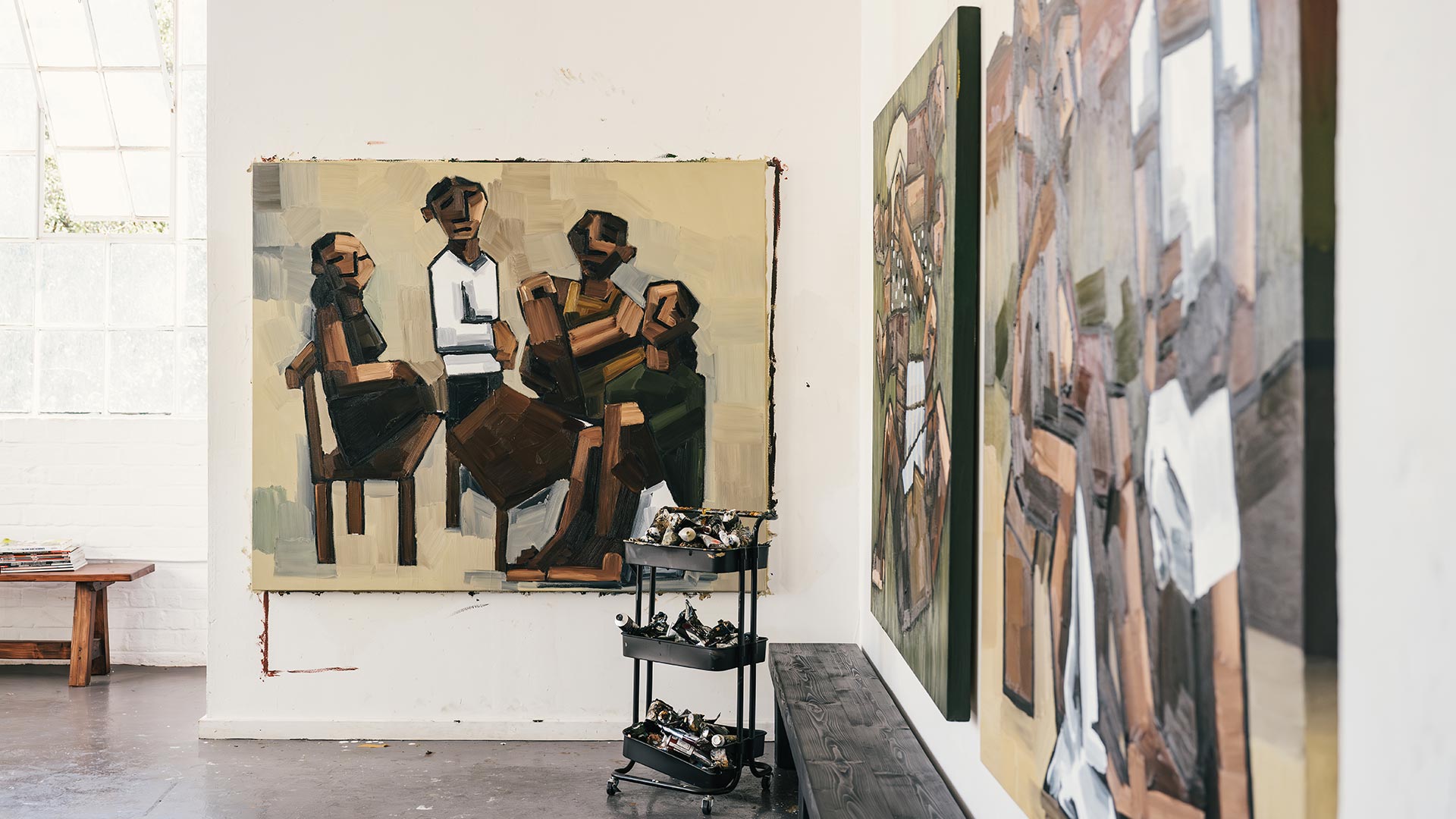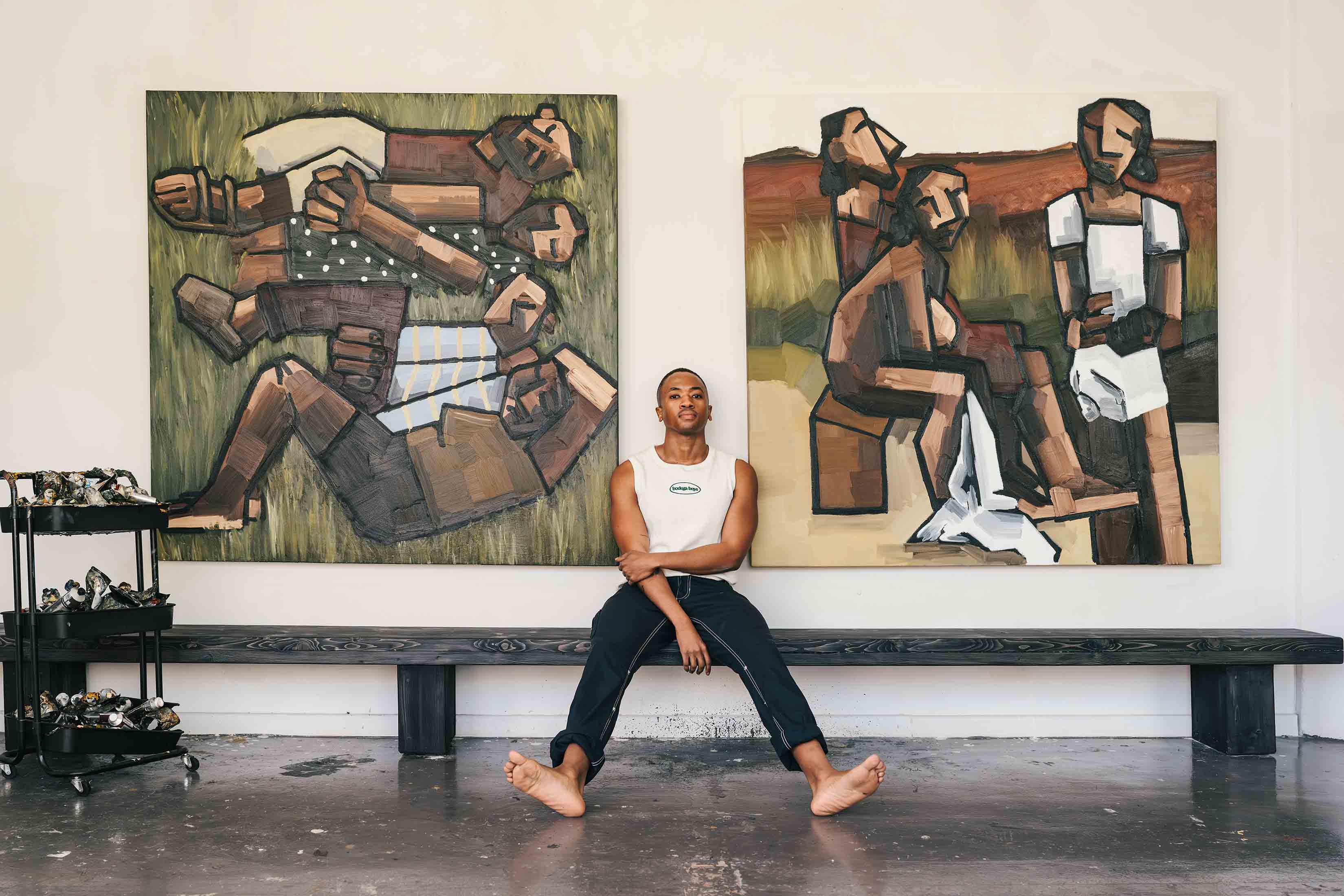Southern Guild Cape Town is pleased to present An Open Letter, the debut solo exhibition by newly represented South African painter Mmangaliso Nzuza on view from August 29 to October 31, 2024. Nzuza’s sensuous oil paintings depict angular, figurative compositions imbued with both the familiar and imagined. Drawing on allegory, atmospheric colour and gestural mark-making, An Open Letter explores themes of community, subjectivity and metaphoric harvest.
Born in 1998 in Durban, Nzuza now lives and works in Cape Town. Returning to South Africa in 2022 after studying at the University of Edinburgh, Nzuza set up a makeshift studio in his garage and began creating representational works in pencil and charcoal. He soon turned to oil painting, committed to studying the language of the medium. In inventing and refining his own style, he sought to convey more feeling and movement, more vulnerability in his subjects. He has arrived at an aesthetic sensibility that is both painterly and restrained, recalling the bold fragmentation of the early 20th-century Cubist painters.
Melding personal memory with fictive spaces and subjects, Nzuza’s immense canvases build cinematic moments of narrative ambiguity. Multiple bodies exist in each frame, arranged in configurations that suggest community, but evoke a sense of self-containment. While earlier works have placed his subjects in domestic spaces, An Open Letter transports them outdoors. In shedding the confinement of interior scenes, Nzuza’s figures expand beyond the politics of home to find ease, pleasure, hope and ritual in the wilds.
Nzuza’s work elicits a comparison to the rich pictorial language of renowned South African artist Peter Clarke. Beyond the visual association in their geometric and dimensional approach to form, there is a vital kinship in the energetic portrayal of the body. Nzuza’s subjects are self-defined, emanating a resolved self-determination with striking sincerity. Contemplating the 'double consciousness' demanded of the Black experience, American sociologist and writer W. E. B. Dubois spoke of a peculiar 'two-ness', the 'sense of always looking at oneself through the eyes of others'. In the gentle, dignified yet unposturing bodies of Nzuza’s canvases, there is a resounding feeling of asserting claim to expansion, rest, joy, stillness and subjectivity. The artist’s hand invites a tender shift in perspective for his figures, from being looked at, to being seen.
An Open Letter is rich in allegorical referencing. Bodies of water become thematic sites of cleansing and sacrament. Fruit reads as a recurring metaphoric invocation of abundance, earthly pleasures, patience and generative love. The human figure acts as a springboard for Nzuza’s dedication to experiments in composition. Drawn without particularity from a learned muscle memory, his bodies contort into exploratory proportions and configurations. His subjects are weighted, exuding solidity and a sculptural presence that seem to declare 'We are here.' Whether in repose, reclining in some imagined field of green, or in action, plucking ripening fruit from the earth, these figures lay proud claim to space. They are rooted, uninhibited and so evidently a part of the greater whole; as stoic and divine as a tree, a lake, the sky itself.
Nzuza plays with the fractional rendering of landscapes and pastoral scenes, working lush fragments of impasto paint into patchwork planes of movement and light. While some paintings present layers of receding rolling hills or fields of tall, undulating grass, other canvases offer more abstract non-spaces, liminal backdrops of soothing colour. Angular black lines act as compositional disruptions, lending some perspectives a dream-like quality while toying with the eye’s perspective of the work’s spatial logic. These negative spaces offer a plurality of readings, holding ample, prompting possibilities for the gazing eye.
In resisting specificity of both place and subject, An Open Letter relies on exploratory form, sensory texturality and colour to create portals into universal emotional experiences.
Read more +
Read less -







 Sign in with email
Sign in with email





